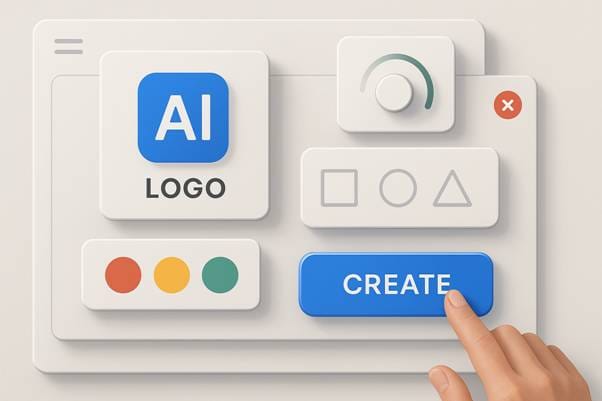AI logo design tools have made it incredibly easy for anyone to create a logo in just a few minutes. But while speed and convenience are a huge plus, the results aren’t always perfect right away. Even great-looking logos often suffer from small issues like poor alignment, uneven spacing, or color combinations that don’t quite work.

If you’re using AI tools to build your brand identity, knowing how to spot and fix these small errors can take your logo from “almost there” to truly polished.
Why Fixing Small Logo Mistakes Matters
Your logo is usually the first thing people notice about your business. It appears on your website, social media, packaging, and more. So when something looks a little “off,” even if it’s subtle — like misaligned text or awkward spacing — it can give the impression that your brand isn’t fully thought out.
For small businesses and startups, these design details aren’t just about visuals. They affect how professional and trustworthy your brand feels. And luckily, you don’t need to be a designer to clean things up — you just need to know what to look for.
Alignment: The Hidden Problem in Many AI Logos
Alignment issues are some of the most common problems in AI-generated logos. Sometimes, text and icons are just slightly off-center. Or the spacing between letters feels uneven.
Let’s say you’ve got a logo where the icon is to the left of your brand name. If the icon looks like it’s floating too far away, or the text appears too close to the edge, it can feel awkward — even if you can’t quite say why.
Quick fix: Use guides or gridlines (if your tool allows) to center everything properly. When possible, adjust spacing manually so that the visual balance feels even. If you’re exporting your logo and editing it in another tool, double-check that the main elements line up with the center or align naturally with one another.
Poor Contrast Can Kill Readability

A beautiful font won’t help your brand if no one can read it. Poor contrast is another major issue in AI-generated logos — especially when text blends into the background or colors are too close in tone.
For example, pale gray text on a light beige background might look “modern,” but it’s not practical. People need to recognize your logo quickly — from a distance, in small sizes, and in different lighting conditions.
Quick fix: Test your logo in black and white to see how it holds up. If the design loses impact without color, your contrast is likely too weak. Try pairing light elements with dark ones, like white text on navy or black text on yellow. Keep accessibility in mind — high contrast helps everyone see your logo clearly.
Font Choices That Work Against You
AI tools often generate logos using trendy or decorative fonts — which can be fun but not always practical. Some fonts might look great in one layout but become hard to read when scaled down. Others might clash with your brand personality.
Let’s say your business is a bakery. A cursive script might seem like the right vibe — but if the swirls make the letters hard to recognize, people may not be able to read your name at all.
Quick fix: Stick with simple, clean fonts that are readable at any size. Test your logo on a small business card and a large poster. If it still works in both cases, you’ve got a solid type choice.
Common AI Logo Mistakes and How to Fix Them
AI tools are great at generating quick designs — but they still need a human touch to look their best. Below are some of the most frequent issues users encounter, along with easy ways to correct them.
- Unbalanced spacing between letters or elements
- Icons and text not aligned properly
- Weak contrast between logo parts
- Fonts that are hard to read at small sizes
- Too many visual elements fighting for attention
- Colors that don’t match your brand tone
- Overused or generic icons
- Logos that don’t scale well across formats
Unbalanced spacing is especially common when an AI logo generator automatically places elements without user input. It’s worth taking a few extra minutes to adjust spacing manually or using a layout grid.
Once you know what to look for, it becomes much easier to fine-tune your logo and avoid common traps.
A Real Example: From AI Draft to Polished Logo
Imagine you’re starting a small candle shop called “Kind Flame.” You use an AI logo generator and get a concept with a flame icon and a handwritten font. It’s charming — but you notice:
- The flame icon is slightly too far from the brand name.
- The orange color blends into the white background in smaller sizes.
- The script font is hard to read on a product label.
Here’s how you fix it:
- Move the icon closer and align it vertically with the text.
- Change the orange to a deeper red-orange for better contrast.
- Swap the font for a softer serif that keeps the cozy vibe but improves readability.
Now you have a logo that keeps the original spirit — but looks clean, readable, and ready for all uses.
When to Use a Design Tool vs. a Fresh Start
Sometimes, small fixes aren’t enough — and you might need to start over. That’s okay! One benefit of using AI tools is how quickly you can generate fresh options.
Platforms like Turbologo make it easy to adjust style settings, colors, and layout, so you can experiment until you get it right. Just remember that design is a process — and a few extra steps can make a huge difference in how people see your brand.
How to Check If Your Logo Works
Once you’ve made adjustments, test your logo in real-world settings:
- Place it on a dark and light background
- Scale it down to favicon or app icon size
- Use it on a mockup (like a t-shirt or packaging)
- Show it to a friend who’s never seen it before — can they read it instantly?
If the answer is yes across these situations, your logo is doing its job.
Final Thoughts: Small Tweaks, Big Impact
AI-generated logos are an amazing starting point for building your brand identity. But they often need small corrections — better spacing, improved contrast, cleaner fonts — to reach their full potential.
Don’t be discouraged by imperfections. Think of them as part of the creative process. With a bit of editing and a sharp eye, you can turn an average logo into something that truly represents your business.
You’ve got the tools. You’ve got the vision. Now you have the knowledge to make your logo shine.





